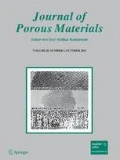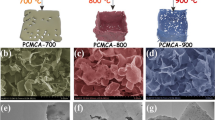Abstract
This paper investigates the influence of the structure, composition, pore size distribution and morphology of three carbon materials obtained from the explosion of acetylene gas on the adsorption performance of brilliant green (BG) dye. During the process, Rosette like carbon (RLC) is obtained in the detonation reaction gas with small amount of ammonia. It shows excellent adsorption properties and high reusability. The adsorption capacity is more than twice of C-nN and C-pN at the concentration of BG of 100 mg/L, the maximum monolayer adsorption capacity of 357.32 mg/g, elimination efficiency can reach 88.5% after 10 cycles of adsorbing BG, which is the best adsorption performance among the currently reported carbon materials. The adsorption equilibrium accords with Langmuir isotherm model and falls into single molecular layer absorption. The temperature and pH value selected have little effect on its adsorption capacity. The excellent properties of RLC contribute to an ideal substitute to the existing adsorbents of carbon materials.



Similar content being viewed by others
References
X. Feng et al., New structural carbons via industrial gas explosion for hybrid cathodes in Li–S batteries. Sustain. Chem. Eng. 7, 12948–12954 (2019)
H. Tavallali, M. Ostovar, Trace spectrophotometric determination of brilliant green in fish farming water samples. Int. J. Chemtech Res. 1, 199–203 (2009)
D. Ziolkowska et al., Adsorption of cationic and anionic dyes onto commercial kaolin. Adsorpt. Sci. Technol. 27(2), 205–214 (2009)
S. Seshadri, P.L. Bishop, A.M. Agha, Anaerobic/aerobic treatment of selected azo dyes in wastewater. Waste Manag. 14, 127–137 (1994)
G. McKay, M. Otterburn, J. Aga, Fuller’s earth and fired clay as adsorbents for dye-stuffs. Water Air Soil Pollut. 24, 307–322 (1985)
A.R. Gregory, J. Elliott, P. Kluge, Ames testing of direct black 38 parallels carcinogenicity testing. J. Appl. Toxicol 1, 308–313 (1981)
K.G. Bhattacharyya, A. Sarma, Adsorption characteristics of the dye, brilliant green, on neem leaf powder. Dyes Pigments 57, 211–222 (2003)
M.G. Mohamed et al., Multifunctional hypercrosslinked porous organic polymers based on tetraphenylethene and triphenylamine derivatives for high-performance dye adsorption and supercapacitor. Polymers 12(10), 2426 (2020). ((1–17))
K.I. Aly et al., A facile synthetic route and dual function of network luminescent porous polyester and copolyester containing porphyrin moiety for metal ions sensor and dyes adsorption. Microporous Mesoporous Mater. 298, 110063 (2020). ((1–11))
N. Zeinali, M. Ghaedi, G. Shafie, Competitive adsorption of methylene blue and brilliant green onto graphite oxide nano particle following: derivative spectrophotometric and principal component-artificial neural network model methods for their simultaneous determination. J. Ind. Eng. Chem. 20(5), 3550–3558 (2014)
A. Molla et al., Selective adsorption of organic dyes on graphene oxide: theoretical and experimental analysis. Appl. Surf. Sci. 464, 170–177 (2019)
M. Wu et al., Carbon counter electrodes in dye-sensitized and perovskite solar cells. Adv. Funct. Mater. 30(7), 1906451 (2020). ((1–34))
R.R.I. Neto, R.J.S.M. Raj, The flash effect in electronic conductors: the case of amorphous carbon fibers. Scripta Mater. 179, 20–24 (2020)
W. Zhang, S.R.P. Silva, Reversible functionalization of multi-walled carbon nanotubes with organic dyes. Scripta Mater. 63(6), 645–648 (2010)
M. Vasuki, S. Punitha, M. Karthika, A comparative study of adsorption of acid blue 9 and brilliant green from aqueous solution by activated carbon derived from coconut shell and palmyra fruit nut shell. J. Adv. Appl. Sci. Res. 1(7), 1–5 (2017)
V. Rawat et al., Oplismenus frumentaceus (Jhangora) husk for activated carbon preparation and its use in adsorption of Brilliant Green dye from aqueous solution. J. Indian Chem. Soc. 90(8), 1223–1231 (2013)
A. Jaiswal, M.C. Chattopadhyaya, Studies of kinetics and isotherm effect on Brilliant Green dye with activated carbon. J. Indian Chem. Soc. 86(12), 1315–1319 (2009)
M. Ghaedi et al., Solid phase extraction and removal of brilliant green dye on zinc oxide nanoparticles loaded on activated carbon: new kinetic model and thermodynamic evaluation. J. Ind. Eng. Chem. 20(4), 1444–1452 (2014)
M. Asadullah et al., Chemical and structural evaluation of activated carbon prepared from jute sticks for Brilliant Green dye removal from aqueous solution. J. Hazard. Mater. 174(1–3), 437–443 (2010)
M.S. Ur Rehman et al., Adsorption of brilliant green dye on biochar prepared from lignocellulosic bioethanol plant waste. Clean: Soil, Air, Water 44(1), 55–62 (2016)
M.P. Tavlieva et al., Kinetic study of brilliant green adsorption from aqueous solution onto white rice husk ash. J. Colloid Interface Sci. 409, 112–122 (2013)
R.L. Liu et al., Biomass-derived highly porous functional carbon fabricated by using a free-standing template for efficient removal of methylene blue. Biores. Technol. 154, 138–147 (2014)
R. Kumar, M.O. Ansari, M.A. Barakat, Adsorption of brilliant green by surfactant doped polyaniline/MWCNTs composite: evaluation of the kinetic, thermodynamic, and isotherm. Ind. Eng. Chem. Res. 53(17), 7167–7175 (2014)
N. Kataria, V.K. Garg, Application of EDTA modified Fe3O4/sawdust carbon nanocomposites to ameliorate methylene blue and brilliant green dye laden water. Environ. Res. 172, 43–54 (2019)
H.I. Chieng, N. Priyantha, L.B.L. Lim, Effective adsorption of toxic brilliant green from aqueous solution using peat of Brunei Darussalam: isotherms, thermodynamics, kinetics and regeneration studies. RSC Adv. 5(44), 34603–34615 (2015)
H.C. Chen et al., Nitrogen doping effects on the physical and chemical properties of mesoporous carbons. J. Phys. Chem. C 117(16), 8318–8328 (2013)
M. Naushad et al., Adsorption of textile dye using para-aminobenzoic acid modified activated carbon: Kinetic and equilibrium studies. J. Mol. Liq. 296, 112075 (2019). ((1–7))
I. Anastopoulos et al., Removal of caffeine, nicotine and amoxicillin from (waste)waters by various adsorbents. A review. J. Environ. Manag. 261, 110236 (2020). ((1–9))
V.S. Mane, I.D. Mall, V.C. Srivastava, Use of bagasse fly ash as an adsorbent for the removal of brilliant green dye from aqueous solution. Dyes Pigments 73(3), 269–278 (2007)
J.T. Li et al., A wormhole-structured mesoporous carbon with superior adsorption for dyes. Carbon 49(6), 1912–1918 (2011)
K.R. Hall et al., Pore- and solid-diffusion kinetics in fixed-bed adsorption under constant-pattern conditions. Ind. Eng. Chem. Fundam. 5(2), 212–223 (1966)
V.S. Mane, I.D. Mall, V.C. Srivastava, Kinetic and equilibrium isotherm studies for the adsorptive removal of Brilliant Green dye from aqueous solution by rice husk ash. J. Environ. Manag. 84(4), 390–400 (2007)
G. Neha, K.K. Atul, M.C. Chattopadhyaya, Adsorption studies of cationic dyes onto Ashoka (Saraca asoca) leaf powder. J. Taiwan Inst. Chem. Eng. 43(4), 604–613 (2012)
R. Kumar, M.A. Barakat, Decolourization of hazardous brilliant green from aqueous solution using binary oxidized cactus fruit peel. Chem. Eng. J. 226, 377–383 (2013)
M. Ghaedi et al., A novel acorn based adsorbent for the removal of brilliant green. Desalination 281(17), 226–233 (2011)
B.K. Nandi, A. Goswami, M.K. Purkait, Adsorption characteristics of brilliant green dye on kaolin. J. Hazard. Mater. 161(1), 387–395 (2009)
V.S. Mane, P.V.V. Babu, Studies on the adsorption of Brilliant Green dye from aqueous solution onto low-cost NaOH treated saw dust. Desalination 273(2–3), 321–329 (2011)
M. Bagtash, J. Zolgharnein, Removal of brilliant green and malachite green from aqueous solution by a viable magnetic polymeric nanocomposite: Simultaneous spectrophotometric determination of 2 dyes by PLS using original and first derivative spectra. J. Chemom. 32(7), 1–9 (2018)
M.S.U. Rehman et al., Adsorption of Brilliant Green dye from aqueous solution onto red clay. Chem. Eng. J. 228, 54–62 (2013)
A. Mittal, D. Kaur, J. Mittal, Applicability of waste materials-bottom ash and deoiled soya-as adsorbents for the removal and recovery of a hazardous dye, brilliant green. J. Colloid Interface Sci. 326(1), 8–17 (2008)
Acknowledgements
This work was supported by the National Natural Science Foundation of China through Grant no. 51802322, the S&T Innovation 2025 Major Special Programme of Ningbo (2018B10054), K. C. Wong Education Foundation (Grant # GJTD-2019-13), Chinese Academy of Sciences Key Project (ZDRW-CN-2019-3) and the Natural Science Foundation of Shaanxi Province no. 2020JQ-857.
Author information
Authors and Affiliations
Corresponding authors
Additional information
Publisher's Note
Springer Nature remains neutral with regard to jurisdictional claims in published maps and institutional affiliations.
Supplementary Information
Below is the link to the electronic supplementary material.
Rights and permissions
About this article
Cite this article
Deng, X., Feng, X., Li, R. et al. A rosette like carbon structure controlled through ammoniation for superior adsorption of cationic brilliant green dye. J Porous Mater 28, 1129–1136 (2021). https://doi.org/10.1007/s10934-021-01067-3
Published:
Issue Date:
DOI: https://doi.org/10.1007/s10934-021-01067-3




